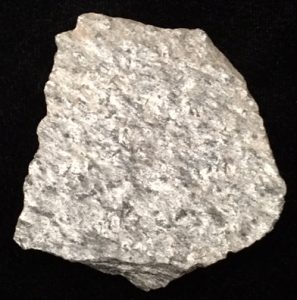
Schist
 This rock is very old, though new to me. I recently picked it up on one of my many desert walks. Having rained the day before, it was rinsed clean and sparkled in the sun. Its glistening was irresistible to me – like a bottle cap to a raven or a tennis ball to a Labrador Retriever. It’s been sitting on my desk ever since. Its shine shifts with changing light. Schist does that. I pick it up, tilt it this way and that, and let the light play over it.
This rock is very old, though new to me. I recently picked it up on one of my many desert walks. Having rained the day before, it was rinsed clean and sparkled in the sun. Its glistening was irresistible to me – like a bottle cap to a raven or a tennis ball to a Labrador Retriever. It’s been sitting on my desk ever since. Its shine shifts with changing light. Schist does that. I pick it up, tilt it this way and that, and let the light play over it.
Schist is a metamorphic rock.
That means it’s been recrystallized by heat and pressure, fundamentally changed from the rock it was to the rock it is. [I can see the metaphor in this – I’ve also fundamentally changed, under pressure, from who I was to who I am. But it’s really more fun to talk about rocks.]
This stone started out sedimentary, probably a shale deposit, composed mainly of clay minerals. It would have been deposited in a low energy aqueous environment; low energy meaning still or very slow moving water, otherwise the tiny clay particles would have stayed in suspension. Then it would have been buried. And then lithified, turned from sediment to stone.
Later, it was subjected to heat and pressure. In the case of schist, medium grade metamorphism, the middle range of temperatures and pressures rocks can be subjected to. During metamorphism, the clays would have recrystallized to platy minerals (like micas and graphite) and elongated minerals (like hornblende), both of which I see in this rock.
The compression it underwent aligned the minerals perpendicular to the direction of stress. That would tell me something about the tectonic history of the area if I found it in place, which I did not. I found it thousands of feet below its outcrop and more than a billion years after it first formed, since the metamorphic rocks here are associated with the Precambrian Sandia Granite. The intrusion of the granite body was the event that metamorphosed the surrounding sediments, now meta-sediments, like this schist.
And so the cycle continues – deposition, lithification, metamorphism, erosion, and deposition – this rock is a sediment again. It made its way down slope and came to rest beside the trail I walk. [Again, I can see all this metaphorically. But sometimes a beautiful thing, like a stone shimmering in the sun, is so perfect it can be just that. It can be my picture, the memory I carry home, from a walk in the desert.]
.

Recent Comments